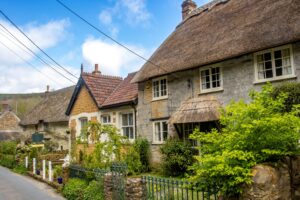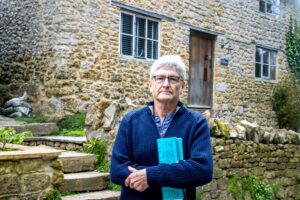How Dorset villages face a stormy future without modern connections
It’s been described as “a beautiful place of deep lanes, orchards and old houses” but it’s those very same deep lanes that are leaving one Dorset village at risk of isolation from modern life.
Nestled in a valley in the heart of west Dorset’s countryside is the picture postcard village of Stoke Abbott.
With its thatched cottages, charming country pub and historic church it presents an idealised image of what many people would see as perfect, olde worlde place to live.
But behind the idyllic scenery is a place just like anywhere else in the UK – a community of 190 residents and businesses that need to live and work in a 21st century world.
Behind the pretty facades of the cottages there live an author, a film producer, a travel consultant – all people that need to be able to work from home who are bringing income into Dorset.
Not to mention the publican that needs to be able to run his village pub, the teenager that requires connectivity to study for their exams and the holiday let owners whose visitors expect to connect to the outside world – and be contactable.
Some of them struggle on very low broadband speeds and, thanks to those deep lanes, all feel the incredible frustration of having extremely poor mobile phone connectivity – many with zero signal.
And when the wind blows hard or if there is simply a power cut… every single one of them can be cut off from the outside world.
This is a case study of just one village but there are many villages like this in Dorset.
Villages that according to OFCOM data have no issues with mobile phone connections (despite real-life evidence proving this wrong). Villages that are living with very poor broadband speeds that are “too expensive” to solve.
Villages that have worse connections than some third world countries. Villages, that according to the government, are not deemed hard enough to reach or too difficult to connect so are not given any special treatment.
Villages that will see telephone landlines switched to an internet service that relies on broadband and a local supply of electricity, leaving them vulnerable every time there is a power cut.
Villages where no solution seems to be in sight for bringing them into the 21st century.
When Storm Eunice hit
It was Valentine’s Day 2022 but there was not much love for one lady called Eunice when she left a wave of destruction across southwest England.
Villagers in Stoke Abbott definitely had no romantic feelings when Storm Eunice tore down the broadband cable that keeps them all connected.
Broadband in the village is patchy as it is and most of it has zero mobile phone coverage, without the menace of a storm to make their situation worse.
But Eunice did just that. She took away the broadband they did have, and the villagers couldn’t turn to their mobile phones as a temporary replacement because, without WiFi, they are next to useless.
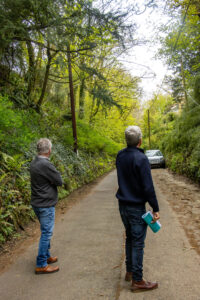
The village was cut off from the modern world.
One day, two day – even three days – may have been bearable but Storm Eunice left the village with no broadband for 13 days.
The situation brought home just how far behind the village was from most people living in the UK.
It made the villagers feel dread at the thought of the national switch off of copper telephone landlines, knowing that any future power outages would leave them very vulnerable indeed.
Here’s just a snippet of first-hand accounts of how Storm Eunice affected Stoke Abbott residents:
The home-run business owner.
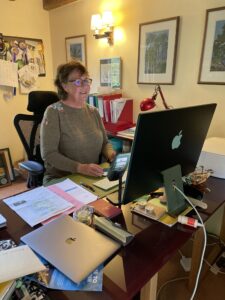
“I run a business from my home. I had to get care for my dog, leave the village and set up with a laptop in a library/community centre/cafe (at least 2 miles away) every day to keep in touch with customers, suppliers, technicians etc. I contracted Covid in the 2nd week and had to drive to a lay-by when I was well enough, with a BT mini-hub and my laptop and try to keep up basic business comms from my car.”
Holiday cottage owner.

“My holiday cottage was without broadband for 2 weeks and power for 4 days – our guests left as there was no phone signal or WiFi. We felt we had to refund them.”
The traveller.
“We needed to download our NHS Covid passes to be able to travel. My abiding memory is of standing in a field on the outskirts of the village trying desperately to download a Covid vaccination certificate with a 2-bar signal that would drop at any time.”
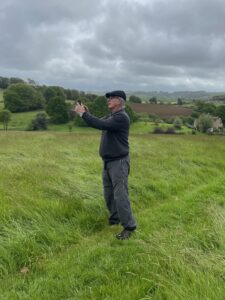
The expectant mum.
“I was 36 weeks pregnant and my doctor was concerned about the baby’s growth because of my gestational diabetes. He needed to determine if it was worth bringing me into hospital for a scan so arranged a zoom call. We drove up the hill to get a phone signal and parked on the side of the road for the zoom consultation. My doctor needed me to measure my stomach which we tried and failed to do on a reclined car seat by the side of the road!”
Those with vulnerable relatives.
“There were several times when dad was on his own and he was in a fragile state. The broadband was out of order and there was no landline phone. It was worrying as he had no way of calling if there was an emergency at the property. We had no way of calling him either. It is very concerning for all the villagers, especially the elderly.”
A tale of three cottages
It’s not just the aftermath of storms that is causing Stoke Abbott connectivity issues.
For some of the residents, terrible broadband speeds are something they must live with every day – and it’s been caused by an anomaly in the antiquated Openreach telephone exchange set-up.
Take John Quarm.
He lives in the middle of a row of three cottages. John’s broadband is supplied via the copper network from the Beaminster telephone exchange. His internet speeds, on a good day, reach around 8mbps.
However, his neighbours either side of him, receive reasonable superfast speeds of around 30mbps.
Why?
Because their broadband comes from the Broadwindsor exchange and the cabinet that provides their fibre broadband is a lot closer to their homes.
You’d think it would be as easy as asking Openreach to switch John over to the other exchange – but it’s not.
This can only be done at great expense to John.
Potential solutions are also frustratingly out of reach.
He could try the BT Universal Service Obligation (USO) that offers help to those with broadband speeds of under 10mbps, but according to the data it holds, John should be getting quicker speeds.
But even if he did qualify, it would nowhere near cover what he would need.
The USO offers either a £3,400 subsidy towards the installation of full-fibre broadband or a 4G home hub.
John asked Openreach how much it would cost to connect him to full-fibre and he was given the eye-watering figure of £60,000.
And the 4G home hub would not work due to the lack of mobile phone coverage in the village.
In the past he could have tried the national gigabit voucher scheme, but he would have needed every single neighbour in the village to join in to make it anywhere near financially viable.
But that scheme has been denied to Dorset residents for two years now as the government pursued its Project Gigabit procurement process.
Project Gigabit is the national delivery programme of full fibre broadband to rural premises that are not in commercial plans.
This should have been John’s solution as the next roll-out of Project Gigabit includes Stoke Abbott – but, there is a but.
Project Gigabit only goes to premises that are not due to be covered commercially.
John’s house, because it is in the Beaminster exchange, falls under that category and here’s why…
In 2020, Openreach announced it was going to connect the Beaminster exchange to full fibre broadband – and from the day of that announcement premises in that exchange were classified as ‘being solved commercially’.
But Openreach will tell you, it generally only covers around 75% of premises within an exchange roll-out like this. It did attempt to cover the whole exchange by using the government’s voucher scheme but even with that help, not every property was connected.
And so, the Openreach engineers left the area and its roll-out in Beaminster was long ago completed – yet John still lives with his very slow broadband.
Meanwhile, his neighbours either side of him, have had the good news they will be in Project Gigabit (even though they get much better speeds than their poor stuck in the middle neighbour John).
John said: “Time and time again I am being let down by national data that falsely claims I can get an ok broadband speed and that I am also due to receive full fibre to the premises. Neither is true and I’m stuck in a limbo where no solution seems to be in sight.”
This situation also applies to about a dozen other residents at the east end of the village who are reliant on a very failure prone copper cable from the Beaminster exchange. Many have been without phone or broadband connection for weeks on end – all without mobile signal.
A frustrated business owner and dad
The village pub is often the beating heart of a community, ready to welcome locals and visitors alike seven days a week.
Publican Kevin Lole and his family have been proudly running The New Inn for 10 years but it has had its challenges thanks to poor connectivity – no more so than during Storm Eunice. 
The tale of how it hit the Lole family shows how impactful no internet or mobile phone connection is – not only to a business but also to the well-being of a family.
Kevin said: “We were forced to close the business for 13 days after Storm Eunice as we had no phone line or Wi-Fi. We currently have Cloud phone lines through our broadband, so once the broadband went down, we also lost our phones and our credit card machine.
“We were unable to do any ordering, accept any bookings, place any orders, accept any credit/debit card payments. I had to drive 2 miles to Beaminster just to contact customers and suppliers.
“Based on previous years’ income in the same period, we lost £9,000 which hit us very hard. If we had 4G, we could have coped without broadband.”
But for Kevin, even with that financial toll, the biggest worry for him was seeing how it affected his teenage son.
At the time of the storm his son was studying for his GCSEs.
Kevin recalled: “Our son had already missed so much schooling due to Covid but he was determined to do well in his exams.
“In this day and age, students need access to the internet for their studies.
“After the broadband outage of Storm Eunice we had to drive our son to the nearest town so he could revise in the car.
“The situation became so awful that in the end we rented a cottage in Bridport so we could have internet and our son could revise. This was another cost, which we really could not afford.
“If we had a power cut today it would be even worse as my son is now doing his A-levels.”
And as Kevin pointed out, for young people having access to the internet is a key part of their social life – especially if you’re a young person living in a rural area where friends may live miles apart in other villages or towns.
“Due to our rural location and the lack of other teenagers in the village, the internet is the only way our son can communicate with his friends,” Kevin explained.
“He would sit in the dark churchyard at night, where sometimes there is a weak 3G signal, to talk to his friends.
“This really is no way to live in the 21st century.”
Why Stoke Abbott is not an isolated case
Stoke Abbott is just one of several villages in Dorset stuck in a continual nightmare of slow broadband and poor mobile coverage – and with no solutions in sight to either.
Dorset Council has carried out its own evaluation of mobile coverage in the county and the findings were stark.
It backs up the anecdotal evidence residents have been telling us, parts of the county have some of the worst mobile connectivity in the country.
We also have 20,859 ‘white premises’ – 11% of all Dorset Council-area premises. These are households and businesses that have sub ultrafast speeds and are in no commercial or government full-fibre rollout programmes.
Here’s just a snapshot of poor connectivity in Dorset:
- Only 58% of premises have gigabit-capable technology (BCP Council area is at 90%, 84% nationally)
- The government national target is 85% gigabit coverage by 2025 (99% by 2030)
- Mobile connectivity is also poor, even going by OFCOM’s data: Dorset Council area has 84% good 4G coverage, compared to 98% in BCP Council area & 93% nationally*
- Nearly 50,000 premises in Dorset that were in commercial broadband plans for 2021-24 have not been delivered
- All these premises will have been ruled out of Project Gigabit contracts and ineligible for the voucher scheme
- Suppliers are only delivering to around 50% of premises they said they would
- Premises in areas of multiple deprivation are 10% less likely to have access to gigabit-capable connectivity
- Premises on industrial and business parks are 30% less likely to have access to gigabit-capable connectivity
- Full gigabit-capable connectivity could deliver potential of £4m savings to Dorset Council residents
*Statistics as of September 2024
If you would like to discuss any of the contents in this case study please email digitaldorset@dorsetcouncil.gov.uk

I have worked in communications for 25 years, first as a journalist and then in public and private sector public relations. From Southampton originally, I have lived in beautiful Dorset for the last two decades. My passion for Dorset has also turned into a passion for landscape photography. My other great loves are my family and Southampton Football Club.

